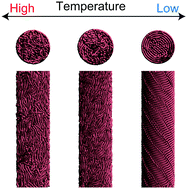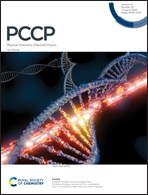Cylindrical defect structures formed by chiral nematic liquid crystals in quasi-one-dimensional systems†
Abstract
Blue phases are three-dimensional self-assembly structures of liquid crystals with a lattice of line defects. They have attracted considerable interest as photonic materials. It is well known that blue phases occur in cholesteric liquid crystals (CLCs) under certain thermodynamic conditions; however, recent studies have indicated that confining surfaces may induce distinctive structural changes. For example, in a previous study, a quasi-two-dimensional (Q2D) confinement system was investigated with the aid of numerical calculations, and a stable Q2D Skyrmion structure was attained. Here, we performed molecular simulations to investigate the CLC phase behavior at the molecular scale for a quasi-one-dimensional (Q1D) nanotube system. Various morphological behaviors of CLCs were observed by changing the temperature and the radius of the nanotubes. In particular, we discovered a self-assembled structure with cylindrical (or ring-like) defects rather than lines by introducing a novel local orientation analysis. Our simulation results show that the self-assembly of CLCs offers a guide to control the intensity in Q1D systems and fundamental knowledge for their application to optical devices.



 Please wait while we load your content...
Please wait while we load your content...